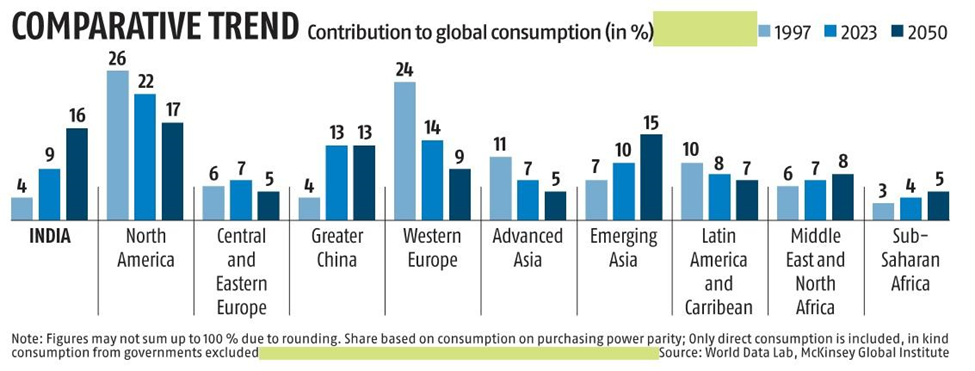India is projected to increase its global consumption share to 16% by 2050, up from 4% in 1997 and 9% in 2023, according to a McKinsey report. Emerging regions, including India, will account for over half of global consumption due to youthful populations and rising incomes, while developed regions will see a decline. India's support ratio is expected to halve by 2050, and its population will grow to 1.505 billion. Enhancing female workforce participation could boost GDP per capita by 4-5%.

India is on track to significantly increase its share of global consumption, projected to reach 16% at purchasing power parity (PPP) by 2050, according to a recent report by the World Data Lab, part of a McKinsey Global Institute analysis titled “Dependency and Depopulation: Confronting the Consequences of New Demographic Reality.” This marks a remarkable rise from 4% in 1997 and 9% in 2023. Only North America is expected to surpass India slightly, with a 17% share in 2050.
PPP is a valuable tool for comparing the purchasing power of different currencies by accounting for price differences across countries.
Over the next 25 years, emerging regions—including India, Latin America, the Caribbean, West Asia, North Africa, and Sub-Saharan Africa—are anticipated to account for more than half of global consumption. This surge is attributed to their youthful populations and rising incomes. In contrast, more developed regions such as advanced Asia, North America, Greater China, and Western Europe are projected to see their consumption share decrease from 60% in 1997 to just 30% by 2050.
The implications of these demographic shifts are profound. As India's income and consumption levels rise, both local and multinational companies will need to adapt their products and services to meet evolving consumer preferences.
The report also highlights significant changes in population distribution. By 2050, only 26% of the global population will reside in first-wave regions, a sharp decline from 42% in 1997. This shift will lead to a redistribution of labor, with later-wave regions accounting for two-thirds of all hours worked globally.
Focusing specifically on India, some notable trends emerge. The current support ratio in India stands at 9.8, but projections indicate this will halve by 2050 and drop to 1.9 by 2100, aligning closely with Japan's current figure. The support ratio reflects the number of working-age individuals available to support each person over 65.
India's share of the global population, which was 23% in 2023, is expected to decrease to 17% by 2050 and further to 15% by 2100, while its population will still grow by 5% from 2023 to reach 1.505 billion. Notably, India’s fertility rate fell below the replacement level in 2019, which is crucial for sustaining population levels.
The demographic changes are also expected to impact economic growth. Between 1997 and 2023, the demographic dividend contributed an average of 0.7% to India’s GDP per capita growth. However, a decline in labor intensity during this period, with a 1.1% reduction in hours worked, offset these gains. As the workforce ages, the contribution to average income is projected to shrink to 0.2% by 2050.
A key opportunity lies in enhancing female participation in the workforce. The research suggests that increasing women's labor force participation by just 10 percentage points could lead to a 4-5% boost in GDP per capita.
In summary, India is poised for a transformative growth trajectory in global consumption, driven by demographic shifts and economic opportunities. Embracing these changes will be essential for maximizing the potential of its workforce and sustaining economic progress.

Comentarios